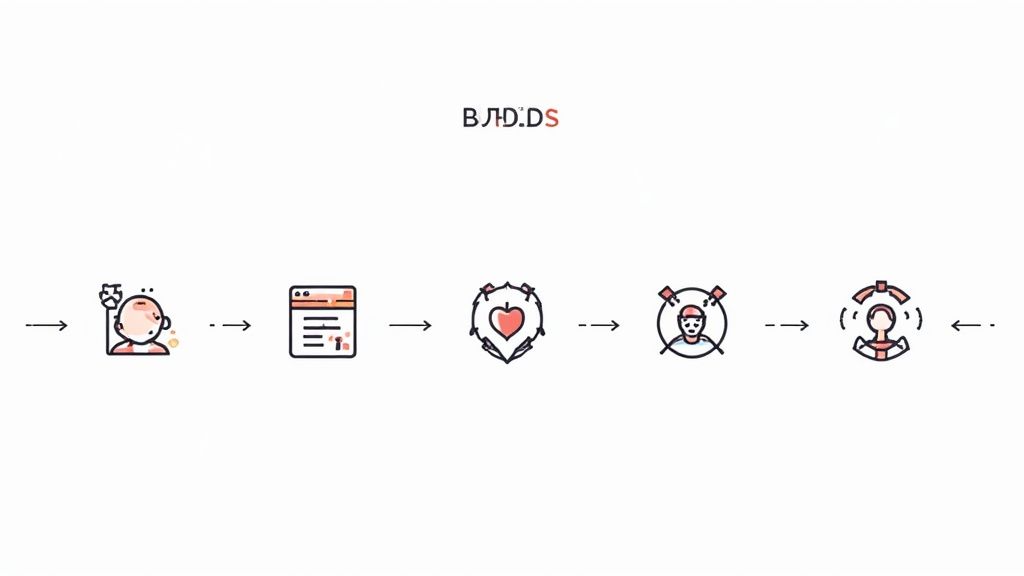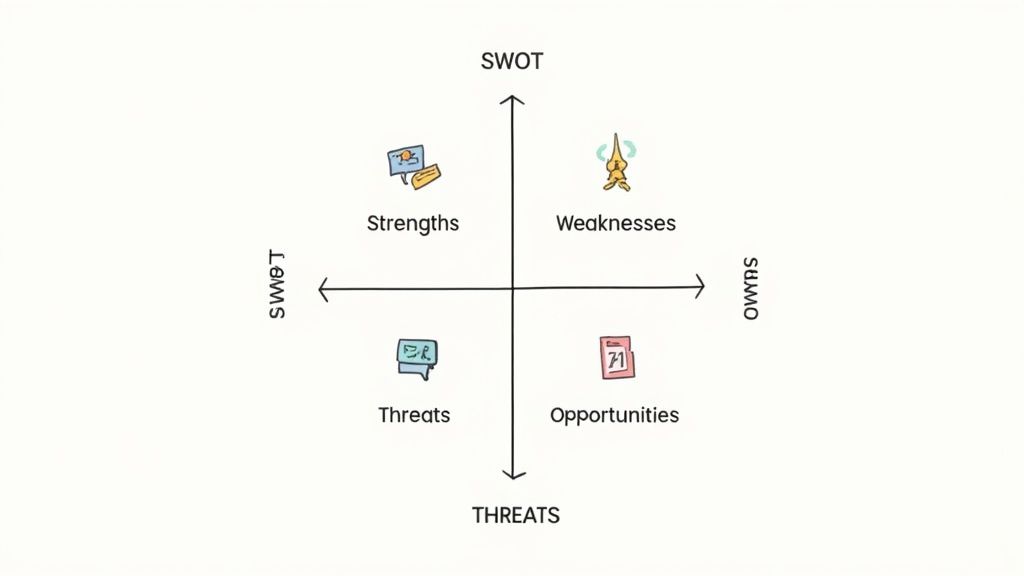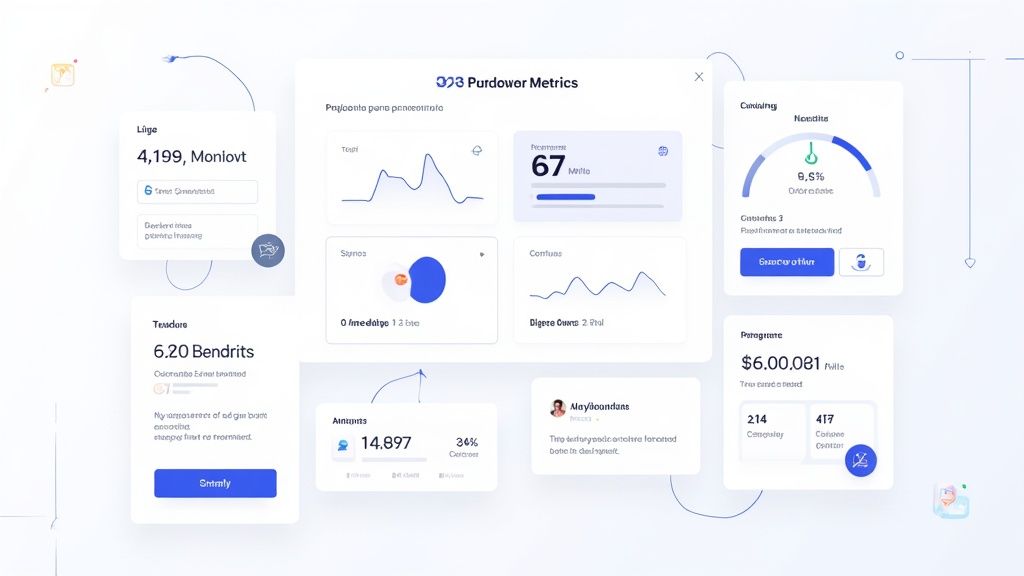The Power of Structured Competitive Intelligence

Systematic competitor analysis is essential for navigating the complexities of the business world. Simply observing competitors isn’t enough. A structured competitor analysis framework provides the foundation for strategic decision-making.
This framework allows businesses to anticipate and shape market changes, rather than just reacting to them. Top-performing companies use these frameworks to proactively identify untapped opportunities and develop sustainable advantages.
This structured approach to competitive intelligence empowers businesses to move beyond reactive strategies and into proactive planning. By understanding the competitive landscape, organizations can make informed decisions.
These decisions impact product development, marketing strategies, and overall business direction, leading to a stronger market position and increased profitability. Competitor analysis frameworks have become a crucial tool for businesses to stay ahead. One widely used framework is the SWOT analysis.
SWOT analysis helps identify a competitor’s strengths, weaknesses, opportunities, and threats. It provides a comprehensive view of a competitor’s strategic position, enabling companies to leverage competitor weaknesses and capitalize on opportunities. Studies show that companies using structured competitor analysis frameworks like SWOT are more likely to adapt to market changes and gain market share. Learn more: Competitor Analysis Framework. But SWOT analysis is not the only powerful framework available.
Beyond SWOT: Exploring Other Frameworks
While SWOT analysis is a foundational tool, other frameworks provide valuable perspectives for comprehensive competitor analysis. Porter’s Five Forces helps analyze industry structure and competition. The Four Corners Model helps predict competitor behavior.
By combining different frameworks, businesses gain a multi-faceted understanding of the competitive landscape. This allows for more informed and nuanced strategic decisions.
Practical Applications of Competitor Analysis Frameworks
Consider a new startup entering the market. A competitor analysis framework helps them identify established players and understand their strengths and weaknesses. This enables the startup to carve out a unique market niche.
For established businesses, these frameworks can highlight emerging threats and opportunities, guiding strategic adjustments to maintain market share. This proactive approach is key to long-term success in any industry.
Mastering SWOT Analysis for Competitive Advantage
SWOT analysis is a cornerstone of any competitor analysis framework. It provides a structured approach to evaluating your competitors, moving beyond simple observation to deliver actionable intelligence. SWOT examines Strengths, Weaknesses, Opportunities, and Threats, helping businesses identify patterns and uncover meaningful competitive insights. These insights, in turn, inform strategic decisions.
Understanding the Four Quadrants of SWOT
A thorough SWOT analysis delves into each component, providing a comprehensive understanding of the competitive landscape. Understanding competitor positioning can inform your own strategy. For example, exploring various brand positioning examples can be beneficial. This exploration helps pinpoint competitor vulnerabilities and discover strategic opportunities.
- Strengths: Identify what your competitor excels at. This could include strong brand recognition, a wide distribution network, or innovative product features.
- Weaknesses: Uncover areas where your competitor struggles. Examples might be outdated technology, poor customer service, or a limited marketing budget.
- Opportunities: Recognize potential areas for competitor growth and improvement. This could involve expanding into new markets, developing new products, or forming strategic partnerships.
- Threats: Analyze external factors that could negatively impact your competitor. These might include emerging competitors, changing consumer preferences, or economic downturns.
Actionable Insights from SWOT Analysis
Effective SWOT analysis transforms identified elements into actionable intelligence. This is where the framework’s real power lies. A competitor’s weakness in customer service, for instance, might present an opportunity for your business to emphasize superior customer support in your marketing efforts. Recognizing a competitor’s strength in a particular product category could lead your business to focus on developing innovative products in a different niche.
Collaborative SWOT Analysis for a Comprehensive Picture
Cross-functional teams play a crucial role in conducting a comprehensive SWOT analysis. Gathering insights from various departments—marketing, sales, product development, and customer service—creates a more nuanced and accurate view of the competitive landscape. This collaborative approach ensures that all relevant perspectives are considered. The sales team might offer insight into competitor pricing strategies, while the customer service team provides information on customer satisfaction levels.
To illustrate the practical application of SWOT, the following table provides a breakdown of each component and offers examples of what to look for when analyzing competitors.
SWOT Analysis Framework Components
A breakdown of the four SWOT components with examples of what to look for in competitor analysis
| Component | Definition | What to Analyze | Example Findings |
|---|---|---|---|
| Strengths | Internal positive attributes of a competitor | Market share, brand reputation, product quality, distribution network | Strong brand loyalty, efficient supply chain |
| Weaknesses | Internal negative attributes of a competitor | Outdated technology, poor customer service, limited marketing reach, high production costs | Low customer retention rate, limited online presence |
| Opportunities | External positive factors for a competitor | Emerging markets, new product development potential, partnerships, weakening rival | Untapped market segment, potential for strategic alliances |
| Threats | External negative factors for a competitor | New competitors, changing consumer preferences, economic downturn, regulatory changes | Increasing competition from low-cost providers, shifting consumer demand |
Key insights from the table highlight the importance of analyzing both internal and external factors when assessing a competitor’s position. Understanding these factors provides a more holistic view and allows for the development of targeted strategies.
By utilizing SWOT analysis within your competitor analysis framework, you gain a deeper understanding of your competitors’ positions, enabling you to formulate more effective strategies for your business. This structured approach leads to better decision-making and a stronger competitive edge.
Alternative Frameworks That Reveal Hidden Insights
While a SWOT analysis provides a solid foundation for competitor analysis, truly effective competitive intelligence requires a broader perspective. Just as a doctor uses multiple diagnostic tools, businesses need a variety of frameworks to gain a comprehensive understanding of their competitive landscape. This section explores additional powerful frameworks that successful companies use to reveal hidden insights and sharpen their competitive edge.
Porter’s Five Forces: Analyzing Industry Structure
Porter’s Five Forces, developed by Michael Porter, shifts the focus from individual competitors to the overall industry structure. This framework examines five key forces that shape competition:
- Threat of New Entrants: How easy is it for new companies to enter the market? High barriers to entry, such as significant capital requirements or strict regulations, reduce competition.
- Bargaining Power of Suppliers: Do suppliers have significant control over prices? A few powerful suppliers can exert pressure on businesses.
- Bargaining Power of Buyers: Can buyers easily switch to different providers? A market with many alternative products gives buyers more power.
- Threat of Substitutes: Are there alternative products or services that could fulfill the same customer needs? The availability of substitutes limits pricing power.
- Competitive Rivalry: How intense is the competition among existing players? Factors like market growth rate and the number of competitors influence rivalry.
By analyzing these forces, businesses can understand the dynamics of their industry and identify potential opportunities or threats. For example, a company in an industry with low barriers to entry might need to focus on differentiation to compete against new arrivals.
The Four Corners Model: Predicting Competitor Behavior
The Four Corners Model helps predict competitor behavior by analyzing four key aspects:
- Motivation: What drives the competitor? Understanding their goals and objectives helps anticipate their actions.
- Current Strategy: What is their current approach to the market? Analyzing their product offerings, marketing efforts, and pricing strategies reveals their current position.
- Capabilities: What are their strengths and weaknesses? This assessment helps determine how effectively they can execute their strategy.
- Management Assumptions: What are their beliefs about the industry and their own position within it? These assumptions can significantly influence their decisions.
This framework allows businesses to move beyond simply observing competitor actions and start anticipating their future moves. For instance, if a competitor is highly motivated by market share growth and has strong marketing capabilities, it might be preparing an aggressive campaign.
Combining Frameworks for a Complete Picture
Just as a single puzzle piece doesn’t reveal the whole picture, relying on just one framework limits your understanding of the competitive landscape. Leading companies often combine multiple frameworks, such as SWOT, Porter’s Five Forces, and the Four Corners Model, to create a more complete and nuanced picture.

This integrated approach enables businesses to make more informed decisions and develop effective competitive strategies. The key is to select the frameworks that best address your specific strategic questions and align with your available data and resources.
Tracking Metrics That Actually Drive Decisions
A strong competitor analysis framework relies on tracking the right metrics. We’re not talking about superficial numbers, but rather data points that provide actionable competitive insights. Successful companies focus on metrics that inform strategic decisions, offering a deep understanding of competitor performance and market dynamics.
Key Performance Indicators: A Multi-Faceted Approach
Effective competitor analysis necessitates a multi-faceted approach to metric tracking, encompassing several crucial areas:
- Market Performance: Tracking metrics like market share trends and segment growth reveals competitor performance within the larger market. This data illuminates emerging trends and potential shifts in customer preferences.
- Financial Metrics: Analyzing competitor profitability and investment priorities offers insights into their financial health and strategic direction. This information can indicate potential weaknesses or opportunities.
- Customer-Focused Measurements: Understanding customer satisfaction and loyalty for competitors reveals what customers value. This knowledge is essential for differentiating your offerings and attracting new customers.
- Operational Benchmarks: Examining competitor productivity and efficiency helps identify areas where they excel or underperform. This comparison can reveal potential improvements for your own business.
Tracking competitor metrics is essential. Metrics like market share, revenue growth rate, and customer retention provide important insights into a competitor’s performance and market position. For instance, market share analysis shows that between 2019 and 2022, companies prioritizing customer retention saw an average market share increase of about 15%, compared to a 5% decrease for those without such strategies.
Revenue growth rates for companies utilizing data-driven competitor analysis frameworks are often significantly higher, sometimes exceeding industry averages by as much as 18%. Metrics like Net Promoter Score (NPS) also demonstrate that companies with strong customer loyalty (indicated by high NPS scores) tend to have higher retention rates, typically around 75%. For further statistics, see: Competitor Analysis Metrics & Market Research. These findings highlight the importance of selecting and analyzing the correct data.
From Data Collection to Strategic Action
Collecting data is just the beginning. The real value comes from interpretation and action. This involves:
- Ethical Data Collection: Employing ethical methods like using publicly available information and industry reports ensures the integrity of your analysis.
- Interpretation Frameworks: Utilizing frameworks like trend analysis and benchmarking helps identify significant patterns and draw accurate conclusions.
- Decision Triggers: Establishing clear decision triggers based on the data, like a significant shift in competitor market share or a drop in customer satisfaction, ensures timely responses.
Overcoming Data Challenges
Data challenges are inevitable. These may include information gaps, conflicting data, or the sheer volume of available information. Experienced competitive intelligence professionals use proven methods to overcome these obstacles. One approach involves prioritizing data sources by reliability and relevance. Another tactic is triangulation – comparing data from multiple sources to validate findings and minimize bias.
Essential Competitor Analysis Metrics
To provide a clear overview of essential metrics, the following table, “Essential Competitor Analysis Metrics”, details key metrics to track across various business areas:
| Metric Category | Specific Metrics | Data Sources | Strategic Implications |
|---|---|---|---|
| Market Performance | Market share, Segment growth, Customer acquisition cost | Industry reports, Public filings, Market research data | Identify growth opportunities, Assess competitive intensity, Inform marketing strategies |
| Financial Metrics | Revenue growth rate, Profit margins, Return on investment | Financial statements, Investor presentations, Analyst reports | Evaluate financial health, Predict future investments, Gauge competitive advantage |
| Customer-Focused Measurements | Customer satisfaction scores, Net Promoter Score (NPS), Customer churn rate | Customer surveys, Online reviews, Social media sentiment | Understand customer preferences, Identify areas for improvement, Enhance customer experience |
| Operational Benchmarks | Production efficiency, Inventory turnover, Order fulfillment time | Industry benchmarks, Case studies, Operational data (if available) | Improve operational efficiency, Optimize resource allocation, Enhance competitive advantage |
Tracking these metrics, as part of a comprehensive competitor analysis framework, helps businesses understand their competitive landscape and make better decisions. This empowers businesses to anticipate market changes and proactively shape their strategies.
Implementing Your Competitor Analysis Framework

A well-defined competitor analysis framework provides the structure for gathering and interpreting valuable business intelligence. Its true power, however, lies in its effective implementation. This involves systematically prioritizing competitors, assembling the right team, and collecting and analyzing data. Finally, it requires reporting findings in a way that drives action. This section offers a practical guide to putting your framework into action.
Prioritizing Your Competitors: Focus Your Efforts
Not all competitors require the same level of scrutiny. Some present a direct, immediate threat to your market share, while others are less significant. Effective implementation begins with competitor prioritization. Focus your valuable resources on analyzing the rivals that truly matter. Consider important factors like market share, target audience overlap, and strategic similarity.
This targeted approach prevents resources from being spread too thin. It also maximizes the impact of your analysis. For example, a local bakery might prioritize analyzing other local bakeries over large supermarket chains. This is because local competitors pose the most direct competition for customers in their immediate area.
Building Your Team: Diverse Perspectives Are Key
Assembling the right team is crucial for a successful competitor analysis program. A cross-functional team brings diverse perspectives to the table, ensuring comprehensive coverage of all relevant areas. Include representatives from key departments like marketing, sales, product development, and customer service.
Each department offers unique insights into competitor activities and their impact on the business. Marketing can analyze competitor messaging and campaigns, while the sales team can provide valuable insights into competitor pricing strategies and competitive wins and losses.
Efficient Data Collection: Working Within Constraints
Data collection forms the backbone of any robust competitor analysis. However, resource limitations can present a challenge. Prioritize data sources and use efficient collection methods. Publicly available information, such as competitor websites, social media profiles, and industry reports, can offer valuable insights without significant investment.
Additionally, tools like SEMrush and Moz can assist in analyzing competitor online presence and SEO strategies. This streamlined approach maximizes insights gained while minimizing costs.
Actionable Analysis and Reporting: Driving Engagement
Raw data is meaningless without proper analysis and interpretation. Transform data into actionable insights using proven analytical frameworks. For instance, a SWOT analysis can help identify competitor strengths and weaknesses. Alternatively, Porter’s Five Forces can reveal broader industry dynamics that affect competition.
Present your findings in clear, concise reports that highlight key takeaways and recommendations for action. Visualizations, such as charts and graphs, can enhance understanding and drive leadership engagement. These reports should be tailored to the specific audience. They should focus on strategic implications rather than just data presentation.
This approach allows for informed decision-making and effective strategy development based on solid competitive intelligence. By effectively implementing your competitor analysis framework, you turn theory into action, gaining a powerful competitive advantage. This implementation involves prioritization, team collaboration, efficient data collection, and actionable reporting, leading to more informed decisions and greater market success.
Converting Competitive Insights Into Market Wins
The true test of any competitor analysis framework lies in its ability to create a tangible competitive advantage. Analyzing competitors isn’t simply an academic exercise; it’s about turning insights into actual market wins. This section explores how successful companies translate competitive intelligence into decisive action. We’ll examine practical ways to use these insights for strategic decision-making and improving market positioning.
Identifying and Prioritizing Competitive Opportunities
A strong competitor analysis framework reveals a wealth of information about the competitive landscape. This includes competitor strengths and weaknesses, emerging market trends, and potential opportunities. The key is to identify and prioritize the opportunities that best align with your business objectives. For instance, if a competitor is overlooking a specific customer segment, that might be a great opportunity for your business to expand its market reach. Similarly, if a competitor’s weakness is in customer service, prioritizing exceptional customer support could be a winning strategy.
Developing Defensive Strategies Against Market Threats
While opportunities represent potential gains, threats represent potential losses. A thorough competitor analysis helps identify these potential threats early on, allowing businesses to develop effective defensive strategies. For example, if a new competitor enters the market with a disruptive product, your business might need to innovate its current offerings or adjust its pricing strategy. Being aware of potential threats and responding proactively can significantly mitigate risk.
Creating Distinctive Positioning: Leveraging Competitor Weaknesses
Competitive intelligence isn’t just about identifying threats and opportunities; it’s about understanding your business’s position within the competitive landscape. By analyzing competitor strengths and weaknesses, you can refine your positioning and emphasize your unique selling propositions. This might involve highlighting features competitors lack, targeting underserved customer segments, or promoting your value proposition in a new way. For example, if competitors are focused on low prices, you could emphasize superior quality or personalized service. Identifying and leveraging competitor weaknesses is essential to carving out your unique market niche.
Case Studies: Success Through Strategic Shifts
Many companies have achieved significant market wins through strategic shifts based on competitive intelligence. One example might be a company identifying growing demand for a particular product feature by analyzing its competitors. By quickly incorporating that feature into their own product line, they can effectively capture market share. Another company might discover a competitor’s vulnerability in their online marketing and adapt its own strategy to take advantage of that weakness.
Avoiding Pitfalls in Competitive Response
While learning from competitors is valuable, simply copying their strategies can be detrimental. Maintaining strategic independence and avoiding purely reactive decision-making is critical. One common pitfall is over-focusing on competitor actions, leading to constant reactions instead of proactive planning. Another pitfall is imitating competitor strategies without considering their alignment with your own business goals and resources. Blindly following competitors can lead to a loss of brand identity and a weakened market position. Instead, businesses should focus on developing their own unique strategies, informed by – but not dictated by – competitor intelligence. By striking a balance between learning from competitors and maintaining strategic independence, businesses can maximize the effectiveness of their competitive analysis framework.
The Future of Competitor Analysis Frameworks

As markets and technology change, so too must the tools and techniques we use for competitive intelligence. This means incorporating new innovations to gain a more dynamic and predictive view of the competitive landscape. Simply analyzing static data is no longer enough. The future of competitor analysis frameworks depends on using advanced technologies and a deeper understanding of the digital sphere.
AI and Machine Learning: Transforming Data Collection
Artificial intelligence (AI) and machine learning are transforming how we collect and analyze data. These technologies can process massive amounts of data from various sources, including websites, social media, news articles, and financial reports. This provides a more complete and real-time understanding of what competitors are doing.
For example, AI-powered tools can automatically track competitor pricing changes, new product releases, and marketing campaigns. This automation allows human analysts to focus on more strategic thinking and interpretation. Machine learning algorithms can also identify subtle patterns and trends in competitor behavior that traditional analysis might miss.
Predictive Insights: Anticipating Competitor Moves
The future of competitor analysis isn’t just about knowing what competitors are doing now; it’s about predicting their next moves. AI and machine learning are essential for generating these predictive insights. By analyzing historical data and identifying recurring patterns, these technologies can forecast future competitor actions.
This might include predicting their next product launch, expansion into new markets, or even their response to industry changes. This predictive ability allows businesses to anticipate market shifts and proactively adapt their strategies.
Social Listening and Sentiment Analysis: Understanding Customer Perceptions
Social listening and sentiment analysis are becoming increasingly valuable parts of competitor analysis frameworks. By monitoring social media discussions and online reviews, businesses can gain key insights into customer perceptions of their competitors.
This can reveal a competitor’s strengths and weaknesses, as well as highlight emerging customer needs and preferences. This information can then be used to refine product development, marketing messages, and customer service approaches. For instance, if social listening reveals widespread customer issues with a competitor’s product, a business can capitalize on this by highlighting the advantages of its own offering.
Navigating Privacy Regulations: Ethical Considerations
With stricter data privacy regulations, businesses must ensure their competitive intelligence practices are ethical and compliant. This means using only publicly available information, respecting intellectual property rights, and avoiding any practices that could be seen as unethical or intrusive. Transparency and responsibility are crucial for building and maintaining trust.
Adapting to a Global and Digital Competitive Landscape
The competitive landscape is becoming increasingly global and digital. Businesses need to adapt their competitor analysis frameworks to reflect these changes. This includes analyzing competitors from various regions, understanding the specifics of international markets, and keeping current with the newest digital marketing trends.
This adaptability requires continuous learning and a willingness to adopt new technologies and approaches. Staying ahead of the curve will ensure your analysis remains relevant and effective in this dynamic and competitive environment.
Ready to improve your competitor analysis and gain a real advantage in the market? ReachLabs.ai provides expert advice and advanced tools to transform your competitive intelligence. Visit ReachLabs.ai today to learn more.





